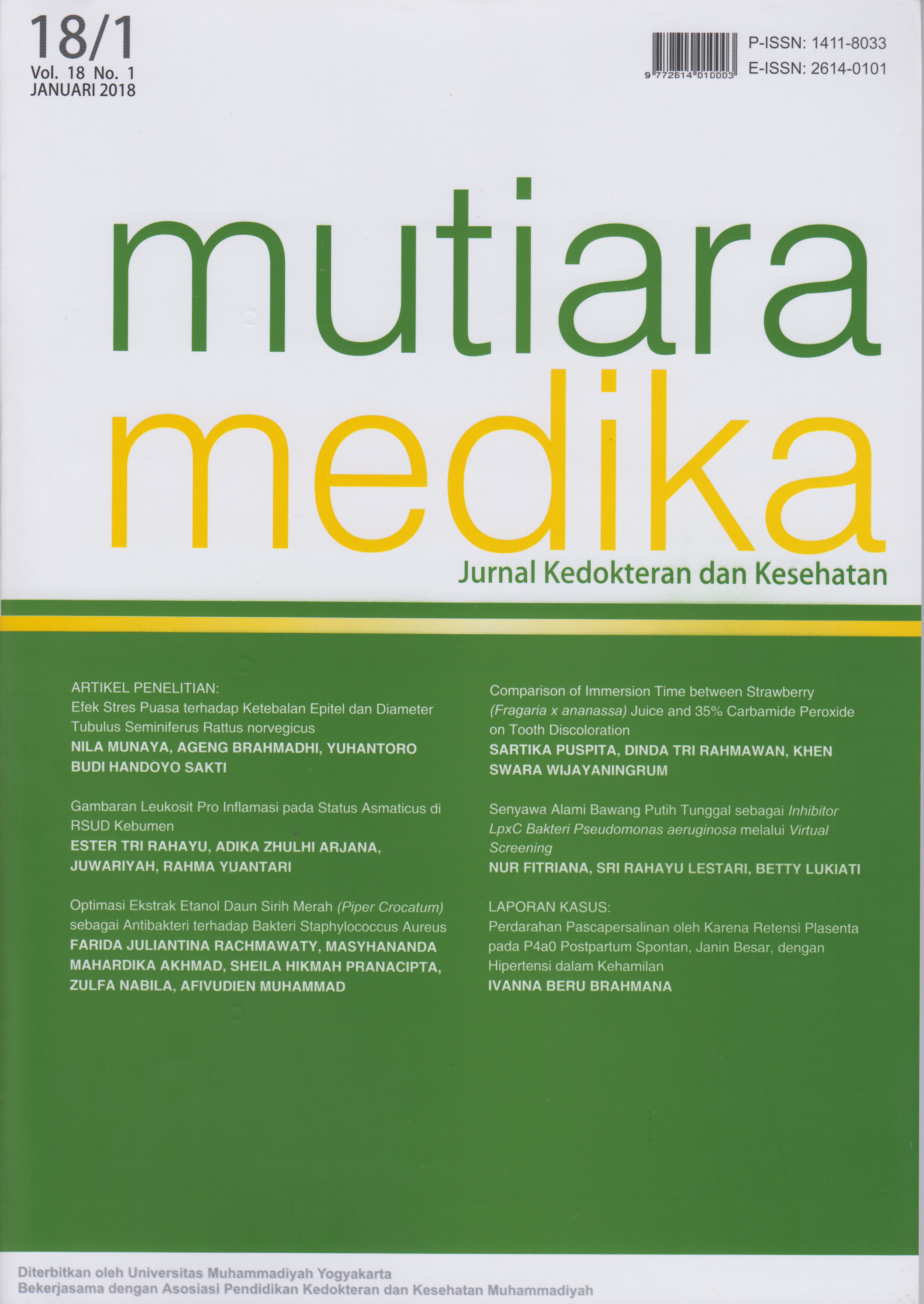Perdarahan Pascapersalinan oleh Karena Retensi Plasenta pada P4a0 Postpartum Spontan, Janin Besar, dengan Hipertensi dalam Kehamilan
DOI:
https://doi.org/10.18196/mm.180112Keywords:
Perdarahan Pascapersalinan, Retensi Plasenta, Postpartum Spontan, Janin Besar, Hipertensi dalam KehamilanAbstract
Perdarahan pascapersalinan pada seorang ibu melahirkan anak keempat, berusia 41 tahun, dimana ketiga persalinan sebelumnya berjalan lancar tanpa komplikasi. Faktor risiko terjadinya perdarahan pascapersalinan yang didapat pada pasien ini berupa: kehamilan yang keempat pada usia ibu lebih dari 40 tahun, janin besar, dan adanya hipertensi dalam kehamilan. Hal yang menarik dicermati pada kasus ini adalah: betapapun ketiga persalinan sebelumnya aman lancar, setiap persalinan harus tetap waspada. Yang ternyata pada persalinan keempat ini mengalami perdarahan pascapersalinan yang memerlukan penanganan yang cepat sehingga pasien dapat tertolong. Kewaspadaan terhadap faktor risiko: kehamilan yang keempat dengan taksiran berat janin besar, adanya hipertensi mengharuskan setiap penolong persalinan untuk siaga terhadap kemungkinan terjadinya perdarahan pascapersalinan. Kasus ini menjadi unik dan perlu untuk pembelajaran pada setiap penolong persalinan adalah kewaspadaan terhadap faktor risiko yang ada pada pasien. Yang ternyata faktor risiko yang telah disebutkan tadi benar-benar terjadi pada pasien. Oleh karenanya dengan mewaspadai faktor risiko, kejadian fatal pada pasien dapat dihindari. Saat terjadi perdarahan pascapersalinan, penanganan dilakukan sesuai dengan manajemen penanganan perdarahan pascapersalinan, yaitu meliputi: masase uterus, pemberian uterotonika, dan pemberian transfusi darah untuk mengembalikan kadar hemoglobin yang normal pada pasien. Pada pasien ini terjadi perdarahan pascapersalinan hingga membutuhkan transfusi darah sebanyak 1250 ml PRC (Packed Red Cell).Dengan mencermati faktor risiko dan penanganan yang tepat, pasien bisa pulang dengan keadaan sehat, dan kontrol kembali dalam keadaan baik.References
Prawirohardjo S. Ilmu Kebidanan. Jakarta: P.T. Bina Pustaka Sarwono Prawirohardjo. 2016.
Anderson J.M. and Etches D. Prevention and Management of Postpartum Hemorrhage. Am Fam Physician. 2007; 75 (6): 875-882.
Weisbrod AB, Sheppard FR, Chernofsky MR, Blankenship CL, Gage F, Wind G, et al. Emergent Management of Postpartum Hemorrhage for the General and Acute Care Surgent. World J Emerg Surg, 2009; 4: 43.
Smith JR. Management of the Third Stage of Labor. Medscape. Updated: Jan 06, 2015.
Magann EF, Evans S, Chauhan SP, Lanneau G, Fisk AD, Morrison JC. The Length of the Third Stage of Labor and the Risk of Postpartum Hemorrhage. Obstet Gynecol, 2005; 105 (2): 290-3.
Magann EF, Lutgendorf MA, Keiser SD, Porter S, Siegel ER, McKelvey SA, et al. Risk Factors for a Prolonged Third Stage of Labor and Postpartum Hemorrhage. Abstract. South Med J, 2013; 106 (2):131-5.
Maughan K., Heim S., Galazka S. Preventing Postpartum Hemorrhage: Managing the Third Stage of Labor. Am Fam Physician, 2006; 73 (6): 1025-8.
Leduc D, Senikas V, Lalonde AB. Active Management of the Third Stage of Labour: Prevention and Treatment of Postpartum Hemorrhage. J Obstet Gynaecol Can. 2009; 31 (10): 980-993.
Urner F., Zimmermann R., Krafft A. Manual Removal of the Placenta after Vaginal Delivery: An Unsolved Problem in Obstetrics. J Pregnancy, 2014: 1- 5.
Sosa CG, Althabe F, Belizan JM, Buckens P. Risk Factors for Postpartum Hemorrhage in Vaginal Deliveries in a Latin-American Population. Obstet Gynecol. 2009; 113 (6); 1313-1319.
Drife J. Management of Primary Postpartum Haemorrhage. Br J Obstet Gynaecol. 1997; 104 (3): 275-277.
Sentilhes L, Ambroselli C, Kayem G, Provansal M, Fernandez H, Perrotin F, et al. Maternal Outcome After Conservative Treatment of Placenta Accreta. Obstet Gynecol. 2010; 115 (3): 526-34.
Downloads
Published
Issue
Section
License
Copyright
Authors retain copyright and grant Mutiara Medika: Jurnal Kedokteran dan Kesehatan (MMJKK) the right of first publication with the work simultaneously licensed under an Attribution 4.0 International (CC BY 4.0) that allows others to remix, adapt and build upon the work with an acknowledgment of the work's authorship and of the initial publication in Mutiara Medika: Jurnal Kedokteran dan Kesehatan (MMJKK).
Authors are permitted to copy and redistribute the journal's published version of the work (e.g., post it to an institutional repository or publish it in a book), with an acknowledgment of its initial publication in Mutiara Medika: Jurnal Kedokteran dan Kesehatan (MMJKK).
License
Articles published in the Mutiara Medika: Jurnal Kedokteran dan Kesehatan (MMJKK) are licensed under an Attribution 4.0 International (CC BY 4.0) license. You are free to:
- Share — copy and redistribute the material in any medium or format.
- Adapt — remix, transform, and build upon the material for any purpose, even commercially.
This license is acceptable for Free Cultural Works. The licensor cannot revoke these freedoms as long as you follow the license terms. Under the following terms:
Attribution — You must give appropriate credit, provide a link to the license, and indicate if changes were made. You may do so in any reasonable manner, but not in any way that suggests the licensor endorses you or your use.
- No additional restrictions — You may not apply legal terms or technological measures that legally restrict others from doing anything the license permits.






